Slave to the Game
Online Gaming Community
ALL WORLD WARS
FRIEND OR FOE?
AIRCRAFT IDENTIFICATION, 1940
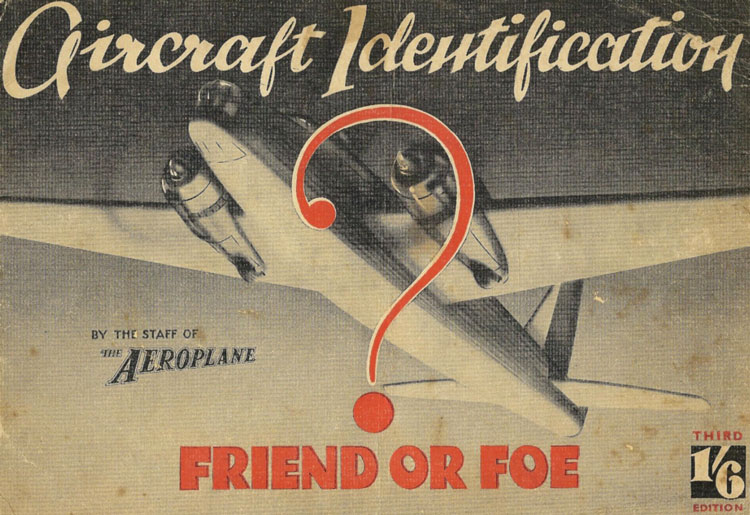
FOREWORD
By E. COLSTON SHEPHERD, B.A., B.Litt. (Oxon), Editor of The Airplane
MOST people had few opportunities before the War to become acquainted with the appearance of foreign military aeroplanes. They were to be seen at rare intervals on the films. Regular readers of aeronautical literature saw pictures of most of them from time to time. If their memories were such as can retain photographic impressions, these people started the War with the advantage of being able to distinguish between enemy and ally. Most other people stood a small chance of recognising a raider and no chance at all of distinguishing between British fighters and such fighters as might be detailed for escort duly with an enemy bomber force.
Many people who might be classed among these innocents have since been embodied in His Majesty's Forces. Those who belong to the anti-aircraft batteries of the Royal Artillery have at their service official publications which assist them in recognising enemy aircraft. At the beginning of the War those publications were either scarce or insufficiently digested, for there was at least one famous occasion on which our own fighters were mistaken for enemy reconnaissance machines, and the anti-aircraft gunners allowed themselves a little target practice to which they were not entitled. However much the fighter pilots may have resented that licence, they were bound to agree that it was all in the usual tradition.
Quite late in the last war, British aeroplanes were "archied" by the French gunners when they were suddenly transferred from the British to the French part of the Front. Occasionally our own guns made things unpleasant in those days for our own aircraft. Unless the gunners are soaked in the characteristic details of different types of aeroplane, they are always liable to mistake one for the other at any height above that at which the Service markings can be seen. When aeroplanes are all of one style—all biplanes or all monoplanes —the smaller points of difference must be known if the types are to be surely identified.
Consider, for instance, the relative similarity in general outline of the German fighter, the Heinkel 112, and the Supermarine Spitfire. If the details can be observed, the lack of a radiator under the starboard wing may reveal the object as a Heinkel; otherwise the line of the wings, rather like those of a gull turned upside down, might enable the observer to be sure that he was looking at a Heinkel. Such near parallels might be multiplied. In the bomber class, but for the angle of the wings, the Heinkel 111 K might be mistaken, with fair excuse, for the Anson. How easily the mistake may be made can be proved by inviting anyone who is familiar with modern aeroplanes to identify one of the silhouettes contained in this book. The odds against his being wrong are at least even.
If the War had proceeded from the start at the pace which many had predicted, for it, there would have been no need for such a publication as this. Experience, dearly bought, perhaps, would have taught the gunners, the Observer Corps, the A.R.P. officials and some of the general public, which were raiders and which were friendly aircraft. They have been spared those hard lessons and we, who have done our best to supplement their training with useful information, have ample reason to know how gladly they received our efforts. There has been a heavy and continuous demand for pictures, drawings and silhouettes of the aeroplanes engaged in the War. And the demand, for the most part, has come from those concerned with air defence.
Here, in compact form, is most of the pictorial information drawn from the pages of THE AEROPLANE which, in past weeks, has been helping to lighten the responsibilities of certain important branches of the air defence. It is not intended for reference while the bombers are overhead. It is offered to those who, by making themselves accustomed to the look of the war machines, would acquire the aptitude to pick them out al sight. It may relieve the tedium of many a gunner's idle hours on duty and make him a vastly more valuable member of the crew at the same time. It may aid many an infantryman who later will have to turn his machine-gun on to ground-strafers. It may help thousands of civilians to take an intelligent interest in the machines which threaten us and in those which defend us.
LONDON, March, 1940.
BRITISH MILITARY AEROPLANES
ALTHOUGH something like 60 different types of aeroplanes are in use in the Royal Air Force and the Fleet Air Arm a few basic types predominate. Hereafter will be found silhouettes and photographs of most of the leading types of aeroplane with which the British forces were equipped at the beginning of the War. Some of them are distinctive in outline. For instance, once seen, nobody could possibly confuse a Handley Page Hampden with any other type. The difference between other types designed for much the same purposes is more subtle. Close examination of the pages which follow should make possible the recognition of those small details which characterise every make. Even more important is the distinctive "sit" of each aeroplane in the air. The illustrations have been selected to bring out these points as well as to convey the general impression on which identification at a distance usually depends.
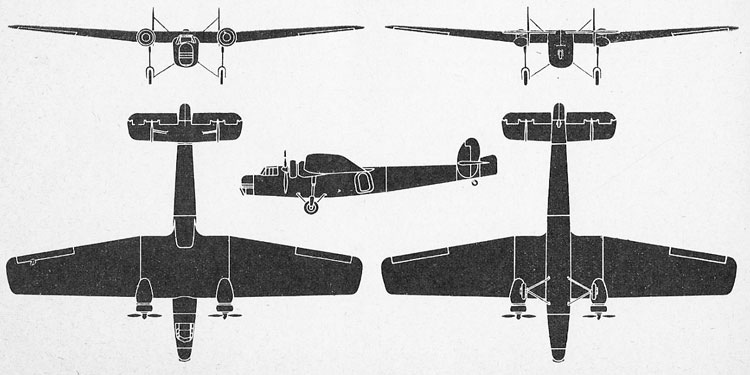
A TROOP-CARRIER.—The Bristol Bombay bomber-transport which is equipped to carry 24 fully-armed soldiers, cruising at 160 mp.h.
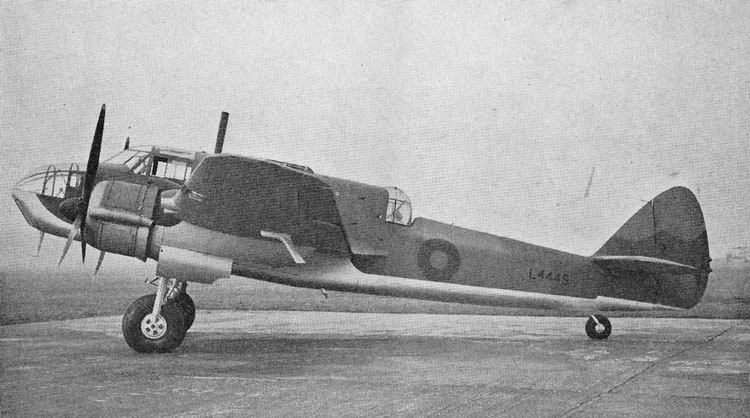
A NEW BRITISH BOMBER—The Bristol Beaufort torpedo-bomber—reconnaissance and general purpose monoplane— which has two 1,065 h.p. Bristol Taurus sleeve-valve motors. No speed may be quoted. It is in production for the R.A.F.
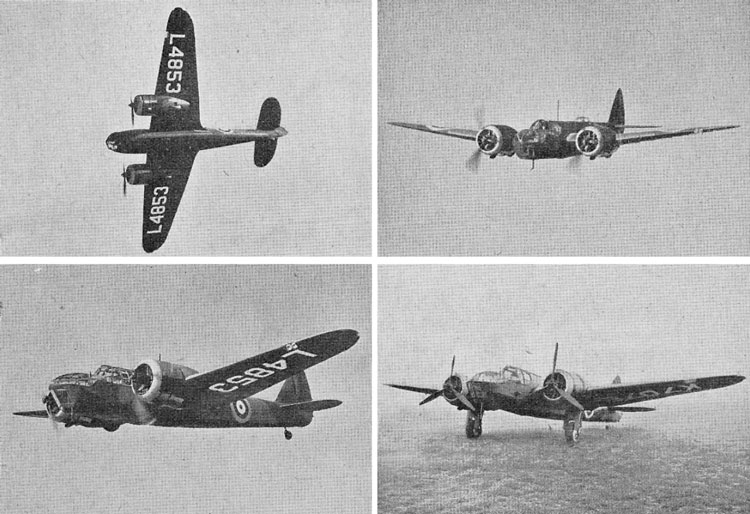
VERSATILITY.—Four photographs of characteristic attitudes of the Bristol Blenheim IV two-motor monoplane which is being built in large quantities for the R.A.F. It has already distinguished itself as a bomber, a multi-seat fighter and for photographic reconnaissance.
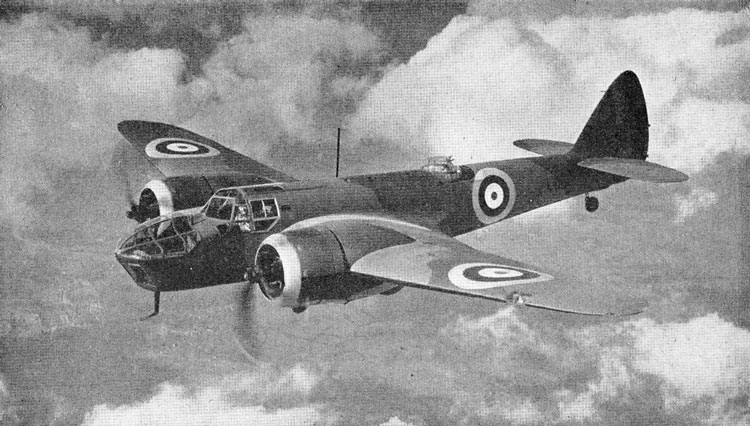
THE LONG-NOSED BRISTOL BLENHEIM Mk. IV FIGHTER-BOMBER equipped with two 920 h.p. Bristol Mercury VIII motors. It has a top speed of 295 m.p.h. with full load, and a range of 1,900 miles. It is built in Canada as well as in England.
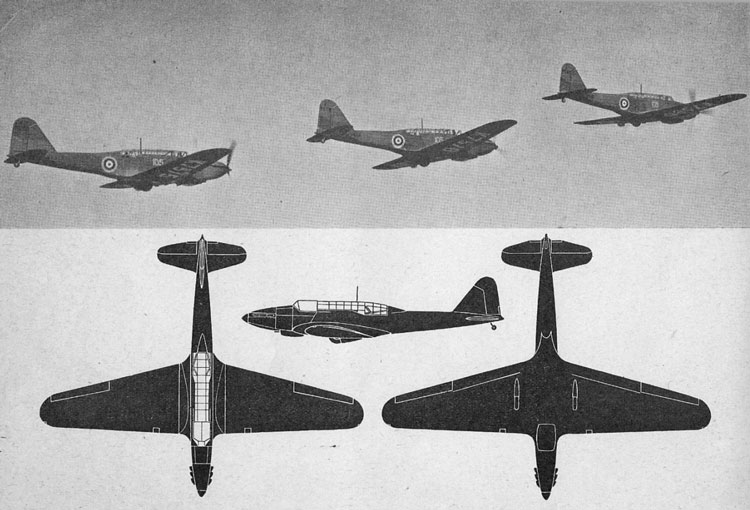
THE FAIREY BATTLE BOMBER (1,030 h.p. Rolls-Royce Merlin II). Wing has taper chiefly on trailing edge. Rounded tips. Long slender fuselage with pointed nose. Long glazed cockpit cover. Radiator under centre section of fuselage. Single fin and rudder. Tail wheel does not retract. Camouflage
brown and green.
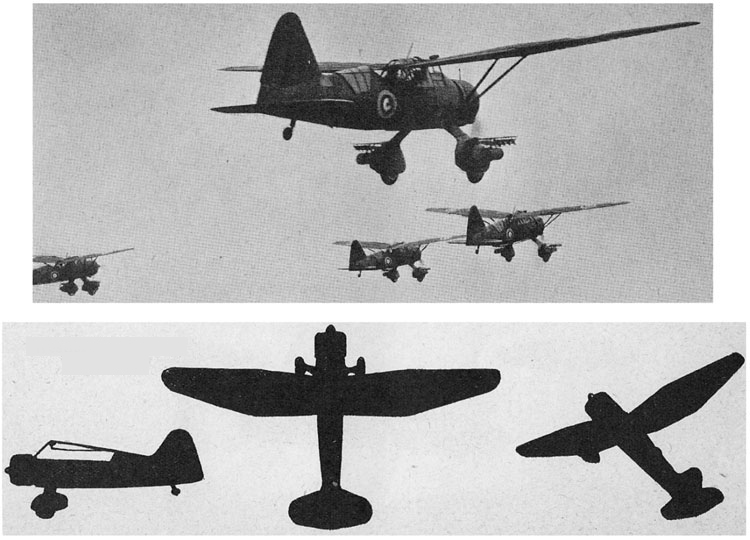
THE WESTLAND LYSANDER (905 h.p. Bristol Perseus XII). High wings tapered inboard and outboard of points half-way along semi-span. Wings braced by Vee-struts to top of fixed cantilever legs of undercarriage. Big spats over wheels house landing lights. Squat, deep fuselage, with big single fin and rudder. Large glazed cockpit enclosure under wings. Fixed tail wheel. Standard camouflage.

THE AVRO ANSON.—General Reconnaissance Bomber (two 350 h.p. Armstrong Siddeley Cheetah IXs). Turret behind cabin on top of fuselage. Rectangular wings with slight taper and rounded tips. Big curved fillet from trailing edge of wings to fuselage. Broad nose with flat front. Big glazed cabin above wings. Deep rear fuselage. Single fin and rudder. High aspect ratio tailplane with sharply tapered trailing edge. Wheels retract forward into long narrow motor nacelles.
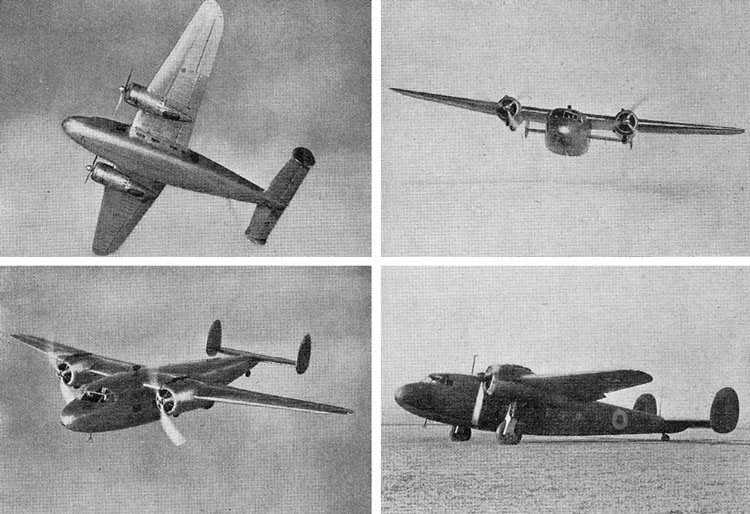
THE DE HAVILLAND FLAMINGO.—Our latest transport aeroplane which is now being built in quantity as a troop carrier also. The two Bristol Perseus motors give it a lop speed of 239 m.p.h. at 7,000 ft. It has done good work, maintaining communications between Great
Britain and the B.E.F. and B.A.F. in France.
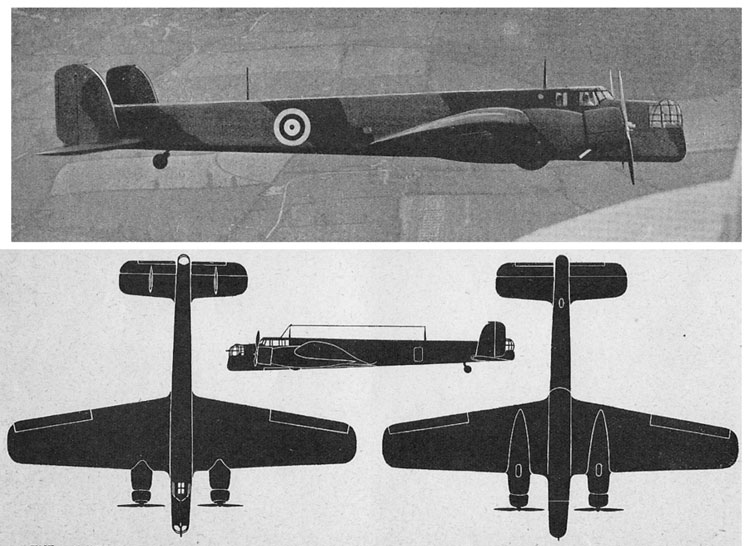
THE ARMSTRONG WHIWORTH WHITLEY Bomber (two 880 h.p. Armstrong Siddeley Tiger VII Is or two 1,030 h.p. Rolls-Royce Merlins). Turrets in nose, behind tail and under fuselage. Rectangular mid-wings, tips square-cut. Taper on trailing edge. Rectangular fuselage which has a characteristic nose-down attitude in the air. Undercarriage retracts forward into motor nacelles, leaving half of wheels
exposed. Twin fins and rudders half-way along tailplane.
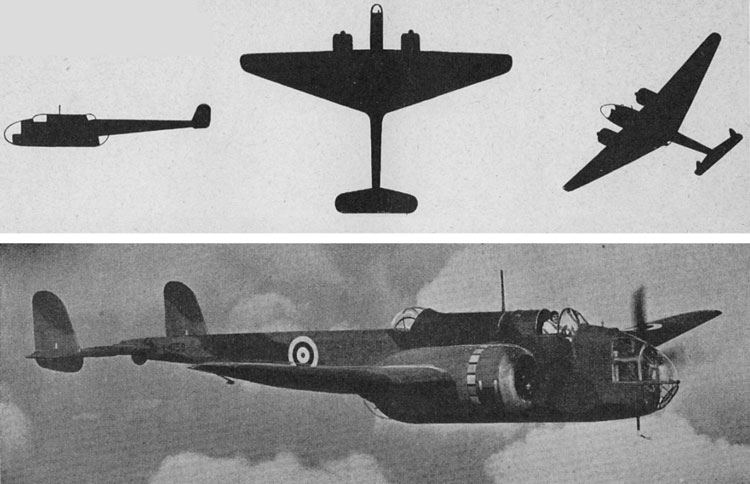
THE HANDLEY PAGE HAMPDEN BOMBER (two 1,010 h.p. Bristol Pegasus XVIIIs). Wing has straight leading edge and sharply tapered trailing edge. Deep, short, slim fuselage, with rounded glazed nose. Twin fins and rudders carried on long slender tail boom.
Undercarriage completely retractable backwards into motor nacelles. Tail wheel retracts also.
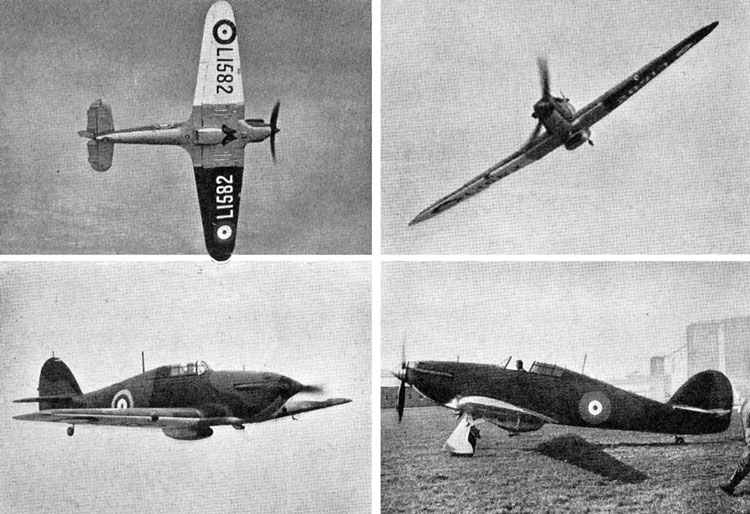
THE HAWKER HURRICANE. —Four photographs to show characteristic attitudes of the Hawker Hurricane single-seat eight-gun fighter (1,030 h.p. Rolls-Royce Merlin II). Later versions have controllable-pitch airscrews, as shown in the bottom right-hand view. The
top speed is 335 m.p.h. at 17,500 ft.

THE FASTEST FIGHTER IN SERVICE.—Four photographs to show characteristic attitudes of the Vickers-Supermarine Spitfire single-seat fighter (1,030 h.p. Rolls'Royce Merlin II). Though the version shown has a fixed pitch airscrew, the Spitfire is now being turned out with a three-blade controllable-pitch airscrew. The maximum speed is 367 m.p.h.
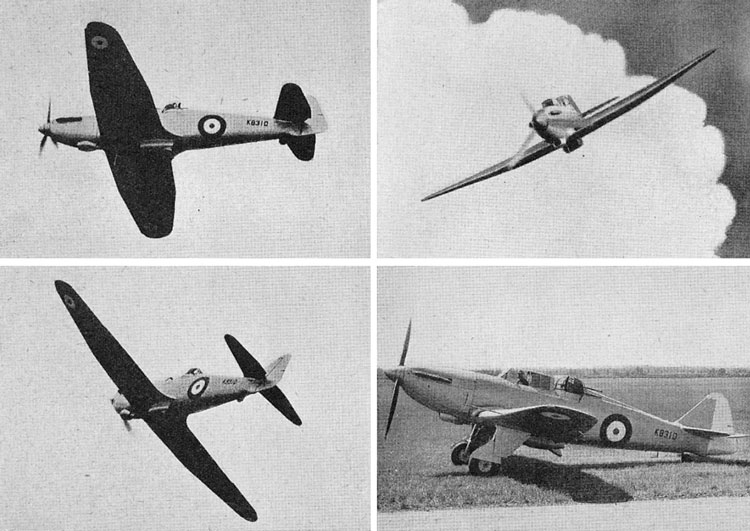
LATEST IN SERVICE.—The Boulton Paul Defiant two-seat fighter(1,030 h.p. Rolls-Royce Merlin III) which is now coming into squadron service with the R.A.F. No performance figures may be quoted, but the top speed is likely to be slightly less than that of our single-seat fighters which have the same motor. The power-operated four-gun turret is a formidable armament.
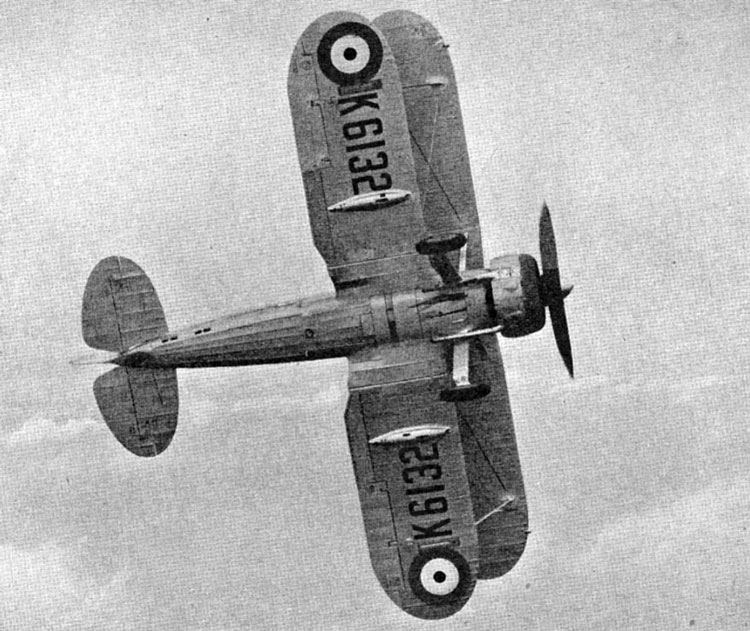
OF THE OLD BRIGADE.—A Gloster Gladiator single-seat fighter (840 h.p. Bristol Mercury IX) the last biplane fighter in service with the R.A.F. The Gladiator has distinguished itself} in action against raiding Heinkels. It is very manoeuvrable and has a top speed of 250 m.p.h.
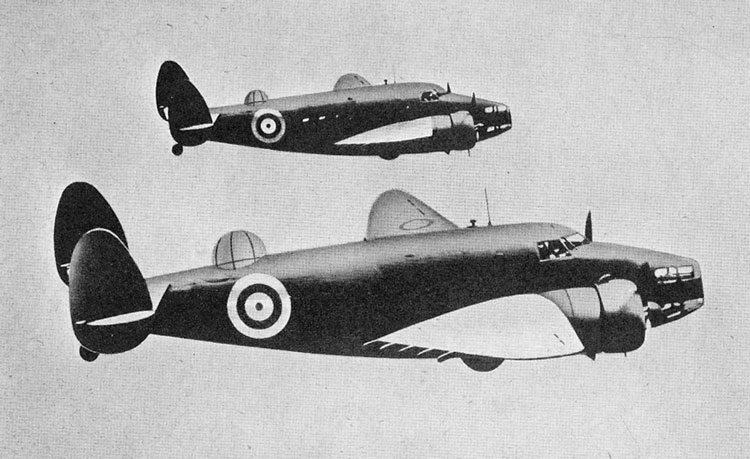
AMERICAN HELP.—The Lockheed Hudson reconnaissance bomber which is in service with the R.A.F. Coastal Command and was responsible for the finding of the " Altmark ". The Hudson has a top speed of 246 m.p.h. and a range of 1,700 miles.
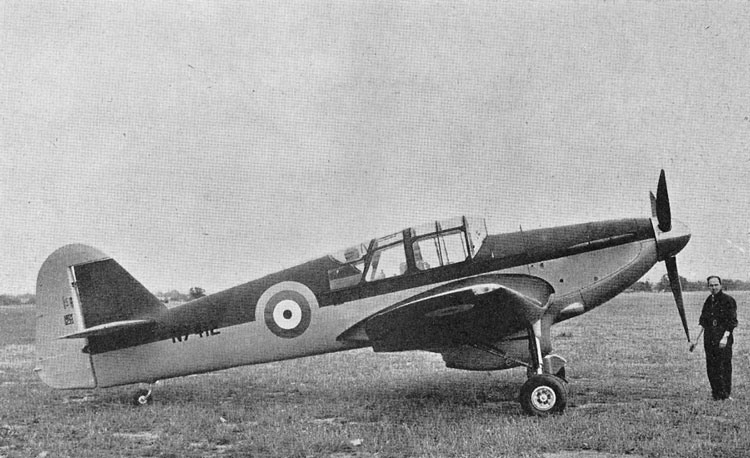
A MODERN TRAINER.—The Miles Master Advanced Trainer (7 ] 5 h.p. Rolls-Royce Kestrel XXX), which first flew in May, 1939, and is
now in full production for the R.A.F. The top speed is 255 m.p.h.
BOMBER COMPARISON—I
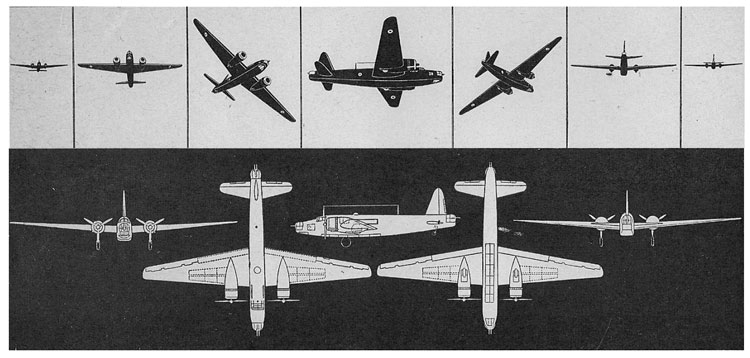
Characteristic silhouettes of the Wellington approaching, turning and going away.
A BRITISH LONG-RANGE BOMBER.—The Vickers-Armstrongs Wellington I (two Bristol Pegasus XVIII nine-cyI. radial motors; 965 h.p. each for take-off. Two-speed superchargers. Rated at 750 h.p. each at 14,750 ft.) All-metal geodetic structure, fabric covering. Crewt five. Colour, green and brown camouflage. Span, 86 ft. 1 in.; length, 61 ft. 3 ins.; height, 17 ft. 5 ins.; wing area, 750 sq.ft. Empty weight, 16,600 lb.: max. loaded weight, 27,000 lb. Max. speed, 265 m.p.h. at 17,000 ft. Max. range, 3,200 miles at 180 m.p.h. at 15,000 ft. Duration, 18 hours. Initial climb. 880 ft. per min. Service ceiling, 26,300 ft.
BOMBER COMPARISON—II
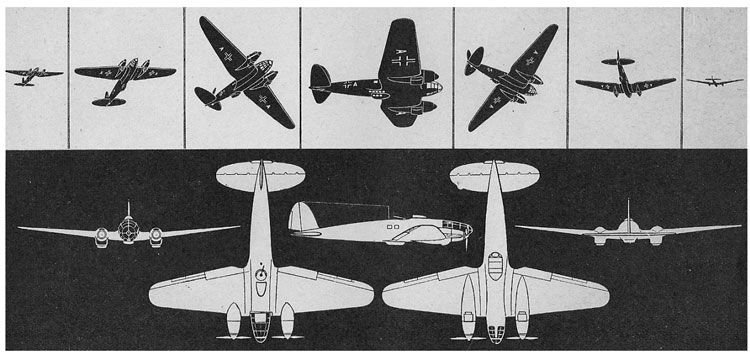
Characteristic silhouettes of the Heinkel approaching, turning and going away.
A GERMAN LONG-RANGE BOMBER.—The Heinkel He 111K Mk. Va (two Junkers Jumo 211A 12-cylinder inverted Vee motors; 1,200 h.p. each for take-off. Two-speed superchargers. Rated at 940 h.p. each at 13,800 ft.) All-metal stressed-skin construction. Crew, four. Colour, upper surfaces and sides black, under surfaces grey-blue. Span, 74 ft. 3 ins.; length, 60 ft. 0 ins.: height, 13 ft. 9 ins.; wing area, 942 sq. ft.; empty weight, 14,100 lb.; max. overload weight, 27,400 lb.; max. speed, 274 m.p.h. at 12,300 ft.; max. overload range, 2,640 miles at 225 m.p.h. at 13,800 ft. Duration, 12 fours. Initial climb, 890 ft. per min. Service ceiling, 26,200 ft.
BOMBER COMPARISON—III
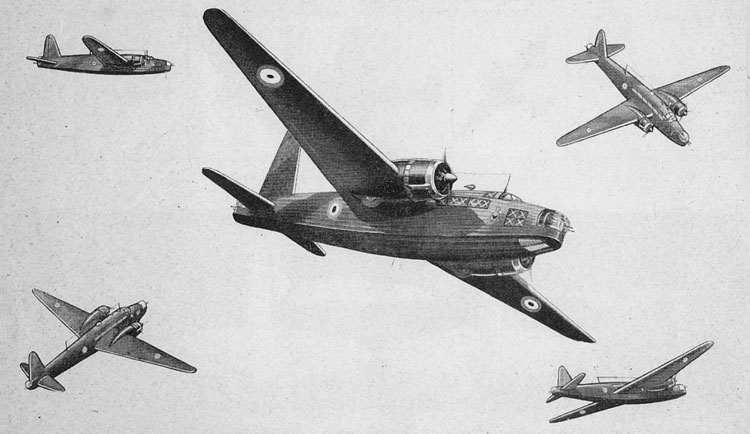
THE VICKERS-ARMSTRONGS WELLINGTON.—Our longest range bomber, which has been used in raids against Heligoland and Wilhelmthaven power operated multi-gun turrets in nose and tail make it a formidable opponent for any fighter.
BOMBER COMPARISON—IV
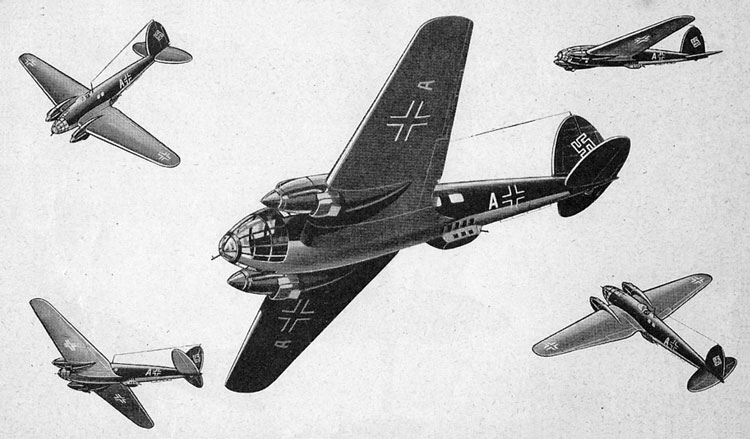
THE HEINKEL He. IIIK Mk.VA2-Germany's standard long-range bomber, which has been used to attack shipping in the North Sea. It differs from the earlier Mk.III versions in the straight taper of the wings and the short nose.
GERMAN MILITARY AEROPLANES

HEINKEL He. III K Mk. III. TWIN-MOTOR BOMBER.-The earlier version of the He. IIIK Mk.V. Easy to recognise by the elliptical plan form
of wings, two motors and roughly elliptical fin and rudder. Shell gun in nose, machine guns above and below wing.
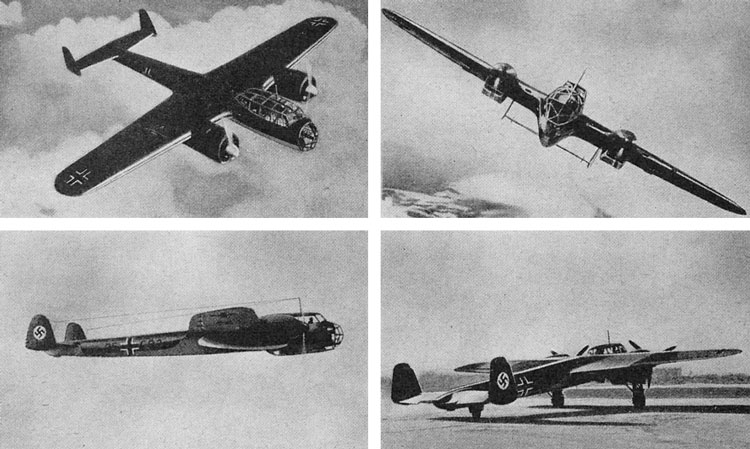
IN THE LUFWAFFE.-Dornier Do 215 long-range reconnaissance bomber of the German Air Force. Versions are in service with both 880 h.p. B.M.W. 132 De air-cooled radial motors and 1,150 Daimler-Benz DB 601 liquid-cooled inverted Vees. The Do 215 is developed from the Do. 17.

THE DORNIER Do. 17.—This bomber, with the Heinkel He. IIIK, forms the equipment of many German bomber- reconnaissance squadrons. The Do. 17 shown has the 770 h.p. B.M.W. upright Vee motors. Later versions in service have the 1,050 h.p. Daimler-Benz inverted V.ees. With these the maximum speed is 292 m.p.h.
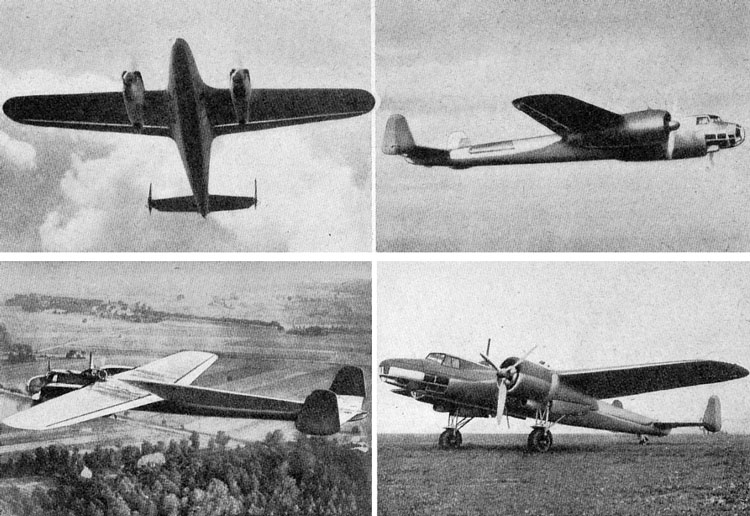
THE DORNIER DO 17.—An aeroplane which has been much used for reconnaissance by the Germans and has proved to be an easy prey for Allied fighters when intercepted. The Do 17 is in service with 660 h.p. B.M.W. VI and 1,050 h.p. Daimler Benz DB.600 liquid-cooled motors and with 880 h.p. B.M.W. 132Dc and 900 h.p. Bramo Fafnir radials. With the DB.600's the top speed is 292 m.p.h. at 14,800 ft.
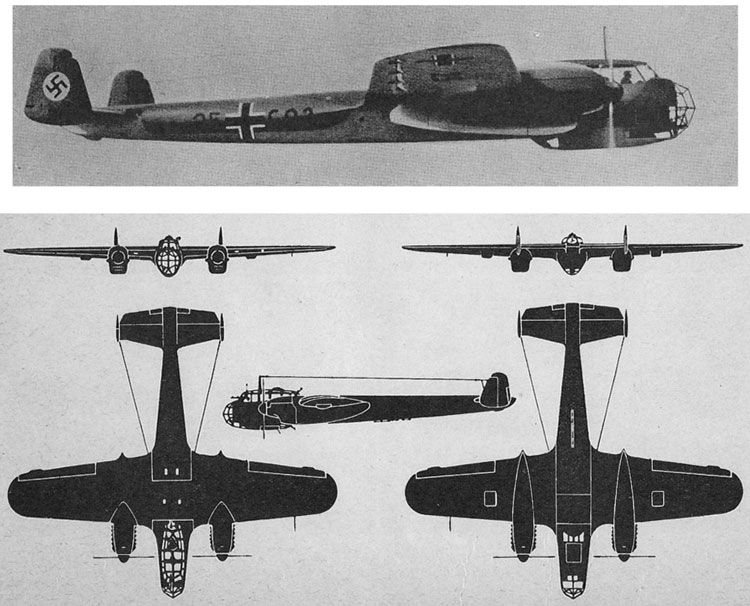
A DORNIER Do. 215 TWO-MOTOR BOMBER of the German Luftwaffe in the same category as our Bristol Blenheim.
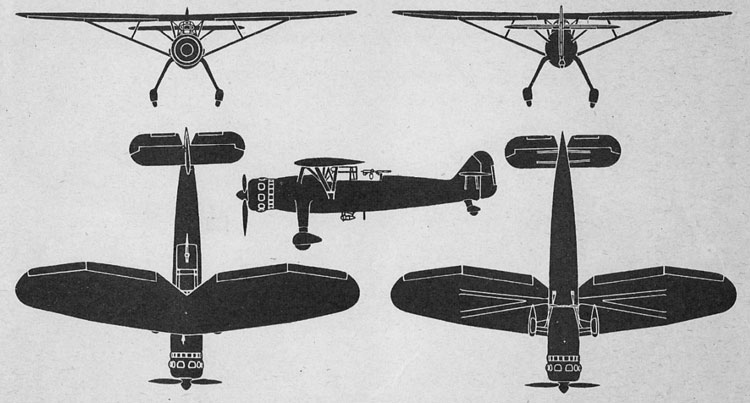
FOR ARMY CO-OPERATION.—The Henschel Hs 126 monoplane (880 h.p. B.M.W. 132 Dc motor) used by the Luftwaffe for short-range
reconnaissance and Army Co-operation duties. It is in the same category as our Westland Lysander.

JUNKERS Ju 86 K bombers of the German Air Force. Many of these aeroplanes are in service, but they are becoming obsolete. Raiding squadrons of Ju 86 Ks over England would prove the sort of prey prayed for by our anti-aircraft batteries and fighter squadrons. The Junkers JuS6 K is the only military aeroplane with Diesel motors which have a deeper and more guttural note, compared with ordinary petrol aero-motors.
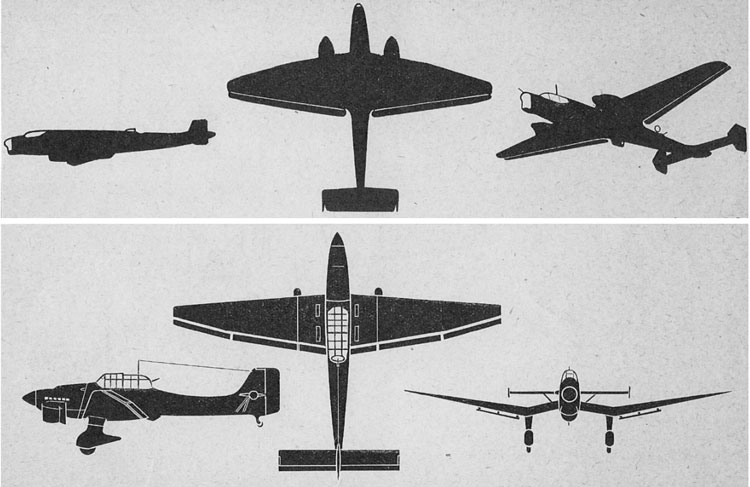
JUNKERS Ju 86 K TWIN-MOTOR BOMBER—The typical Junkers wing, tapered equally on leading and trailing edges, has the well-knowh Junkers " double-wing " trailing flap. The twin fins and rudders are above the fuselage. The nose has a prominent circular bump on top of the rectangular shape.
FOR SHORT-RANGE ATTACKS—The Junkers Ju 87 B (1,200 h.p. Junkers Jumo 211) dive bomber of the German Air Force. It was used
with success against Poland.

GERMANY'S BIGGEST BOMBER-The Junkers Ju 89 bomber- transport (four 1,200 h.p. Junkers Jumo 211A motors). The loaded weight is about 56,000 lb. (25 tons). The Ju 89 has gun positions in the nose and tail as well as above and below the fuselage. It would make a magnificent target for anti-aircraft fire or attacking fighters.
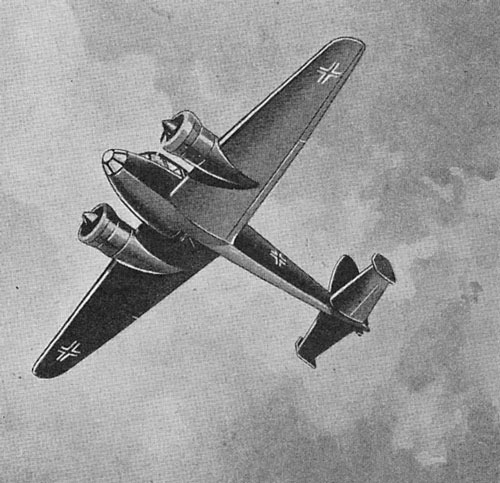
A FAST BOMBER.- The Junkers Ju 88 K
bomber designed for dive-bombing as well as precision
bombing.
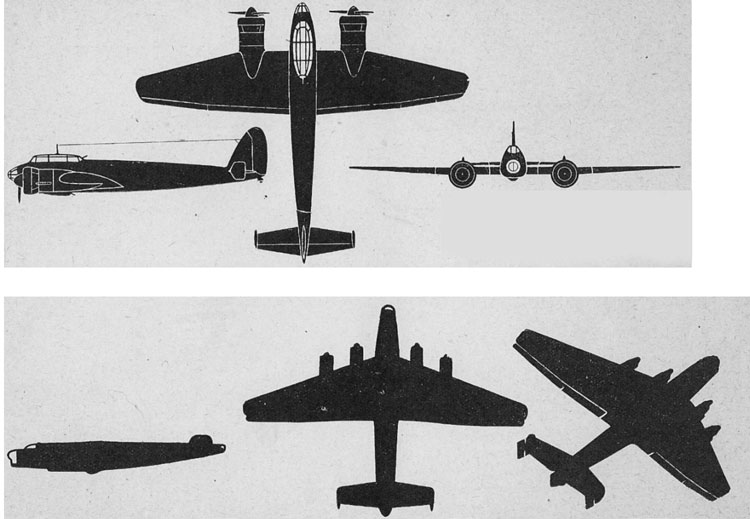
A NEW GERMAN BOMBER.-The Junkers Ju. 88 K (two 1,200 h.p. Junkers Jumo 211 motors), which is the latest German high-speed bomber. It has a maximum speed of 317 m.p.h., but poor defence against attacking fighters.
JUNKERS Ju. 89 K FOUR-MOTOR BOMBER.—Wing has a very sharp taper on leading edge and little taper on trailing edge at which are Junkers 44 double-wing" flaps. Daylight can be seen between leading edge of flap and trailing edge of wing. Double fins and rudders are mounted at their mid-points on tailplane across top of the fuselage.
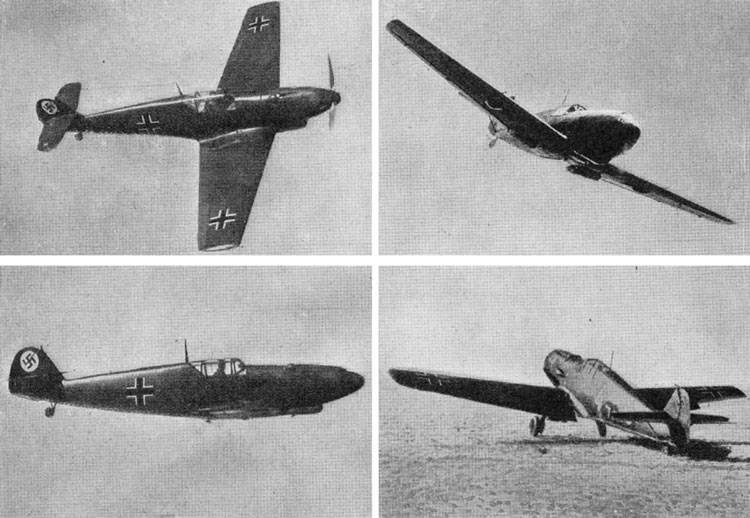
THE MESSERSCHMITT Me 109.-Germany's standard single-seat fighter armed with one cannon and four machine guns. In its latest form with the 1,150 h.p. Daimler-Benz DB.601 motor the top speed is 354 m.p.h. at 12,300 ft. Earlier versions had the 640 h.p. Junkers Jumo 210 and the 1,050 h.p. Daimler-Benz DB.600 motor and a comparatively low performance.
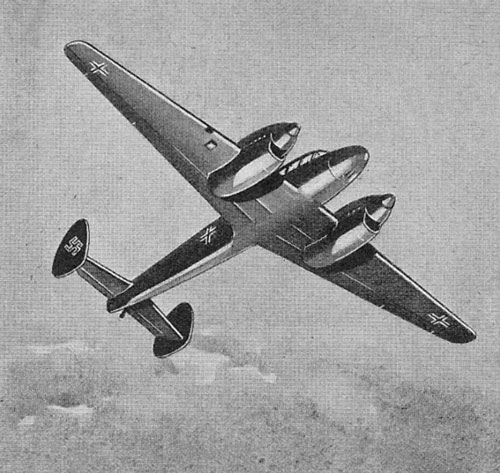
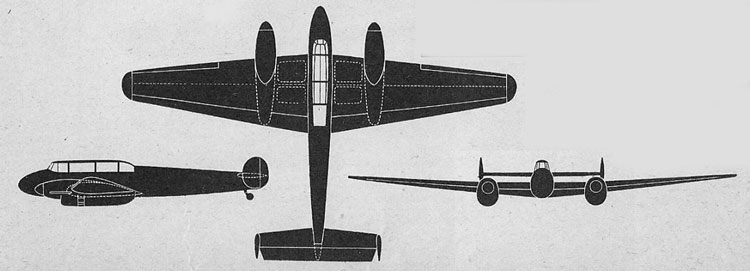
GERMANY'S MOST FORMIDABLE FIGHTER.—The Messerschmitt Me 110 two-motor two-seat fighter (two 1,165 h.p. Daimler-Benz DB.601 motors). It has a top speed of 365 m.p.h.y a range of 1,750 miles at 175 m.p.h., and is armed with two cannon and four machine guns. Below is a Messerschmitt works drawing of the Me 110. The Messerschmitt Me 110 forms the chief equipment of the Schumacher Group with which our Vickers-Armstrongs Wellingtons have been in action over the North Sea. The Me 1 10 may be used to escort German bombers over England if serious raiding begins. The big span of the wings and twin fins and rudders are distinctive.
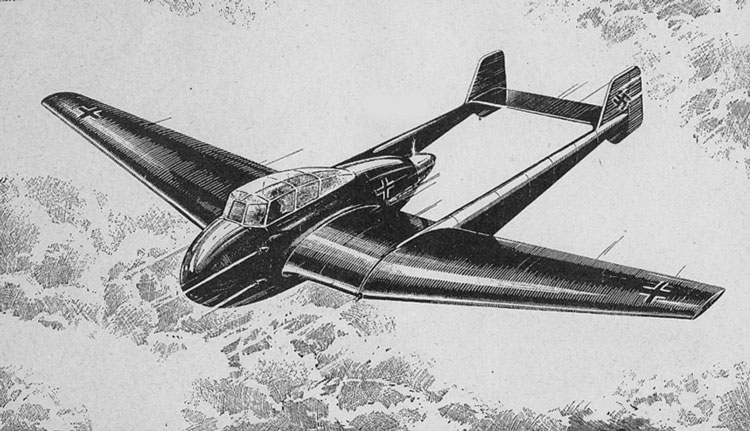
GERMANY'S FASTEST F!GHTER.-The new Focke-Wulf Fw 198 single-seat pusher fighter of the German Air Force. The 1,360 DB.601 motor gwes a top speed of 368 m.p.h. at 19,000 ft. The Fw 198 is the newest fighter in service.
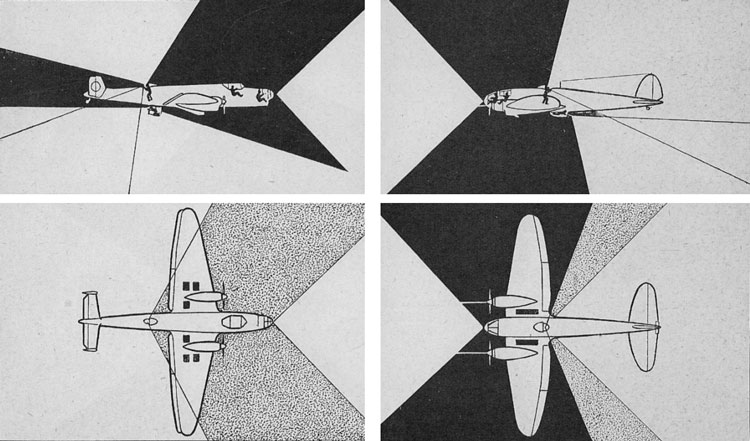
FIELDS OF FIRE - I. Two-motor Bombers of the German Air Force
The Junkers Ju. 86 K (two 750 h.p. Junkers Jumo 205 Diesels). Span, 73 ft. 9 ins.; length, 58 ft. 8 ins.; top speed, 224 m.p.h. at sea-level. Service ceiling, 20,700 ft., crew four. Three movable machine-guns, retractable dustbin.
The Heinkel He. 111 K Mk. V (two 1.150 h.p. Daimler-Benz DB.601 s). Span, 74 ft. 3 ins. ; length, 60 ft. 0 ins.; top speed, 274 m.p.h. at 12,300 ft. Service ceiling, 26,200 ft., crew four. Three movable machine-guns, two *' motor cannons."
The black areas are the blind spots not covered by the fields of fire of any guns. The grey areas are those covered by guns in one plane only and hence blind for attack from one direction. The light areas are those covered by the fields of fire of defensive guns. Vulnerable points, the position of the crews and of the fuel tanks, are indicated in black.
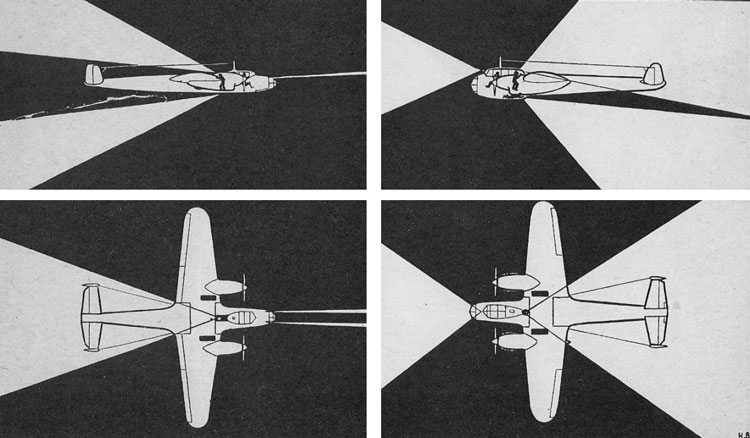
FIELDS OF FIRE - II. Two-motor Bombers of the German Air Force
The Dornier Do. 17 (two 1,050 h.p. Daimler-Benz DB.600s). Span, 59 ft. 2 ins.; length, 52 ft. 6 ins.; top speed. 292 m.p.h. at 11,800 ft. Service ceiling, 30,400 ft., crew three. Two fixed and two movable machine-guns.
The Dornier Do.215 (two 1,150 h.p. Daimler-Benz DB.601s). Span. 59 ft. 2 ins.; length, 53 ft. 6 ins.; top speed, 312 m.p.h. at 12,300 ft. Service ceiling, 29,600 ft., crew three, Three movable machine-guns.
The black areas are the blind spots not covered by the. fields of fire of any guns. The light areas are those covered by the fields of fire of defensive guns. Vulnerable points, the position of the crews and of the fuel tankst ate indicated in black.
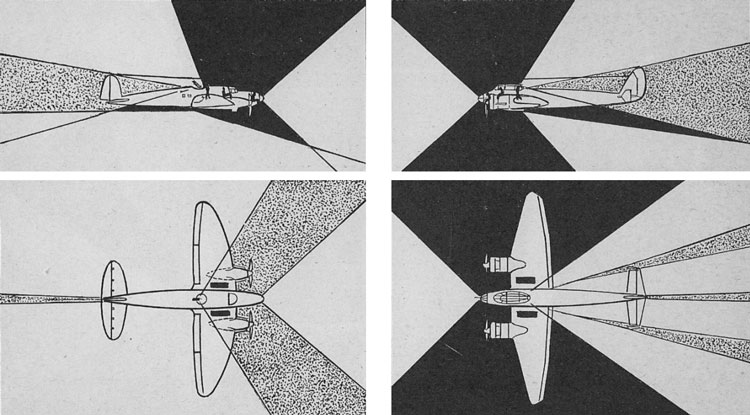
FIELDS OF FIRE - III. Reconnaissance Bombers of the German Air Force
THE HEINKEL He. IIIK. Mk. III (two 1,050 h p. Daimler-Benz DB.600s) —Span, 74 ft. 3 ins.; length, 57 ft. 9 ins.; top speed (dustbin extended), 236 m.p.h. at 13,100 ft. Service ceiling, 21,000 ft., crew four. Three movable machine-guns. Retractable dustbin underneath fuselage.
THE JUNKERS Ju. 88K (two 1,200 h.p. Junkers Jumo 211s).—Span, 56 ft. o ins. length, 47 ft. 7 ins.; top speed, 317 m.p.h. at 15,600 ft. Service ceiling 29.800 ft., crew
three or four. Three movable machine-guns.
The black areas are the blind spots not covered by the fields of fire of any guns. The grey areas are those covered by guns in one plane only and hence blind for attack from one direction. The light areas are those covered by the fields of fire of defensive guns. Vulnerable points,
the position of the crews and of the fuel tanks, are indicated in black.
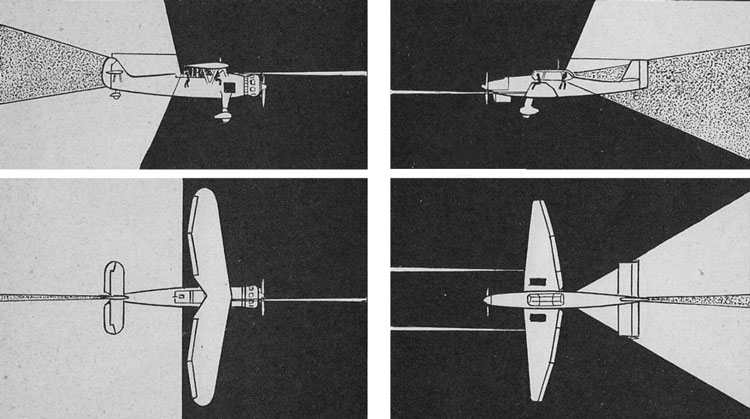
FIELDS OF FIRE - IV. Reconnaissance Bombers of the German Air Force
THE HENSCHEL Hs. 126 (one 880 h.p. B.M.W. 132Dc).—Span, 47 ft. 7 ins.; length, 35 ft. 7 ins.; top speed. 221 m.p.h at 9,850 ft. Service ceiling, 28,000 ft., crew 2. One
fixed machine-gun, one movable machine-gun.
THE JUNKERS Ju. 87 (one 1,200 h.p. Junkers Jumo 211).—Span, 45 ft. 4 ins.; length, 35 ft. 6 ins.; top speed, 242 m.p.h. at 14,000 ft. Service ceiling, 27,900 ft., crew 2. Two fixed machine-guns, one movable machine-gun.
The blind areas and vulnerable spots of some German reconnaissance bombers. The black areas are the blind spots not covered by the fields of fire of any guns. The grey areas are those covered by guns in one plane only and hence blind to attacks from one direction. The light areas are those covered by the fields of fire of defensive guns. Vulnerable points, the position of the crews and of the fuel tanks, are indicated in black.
SILHOUETTES TO SCALE—BRITISH
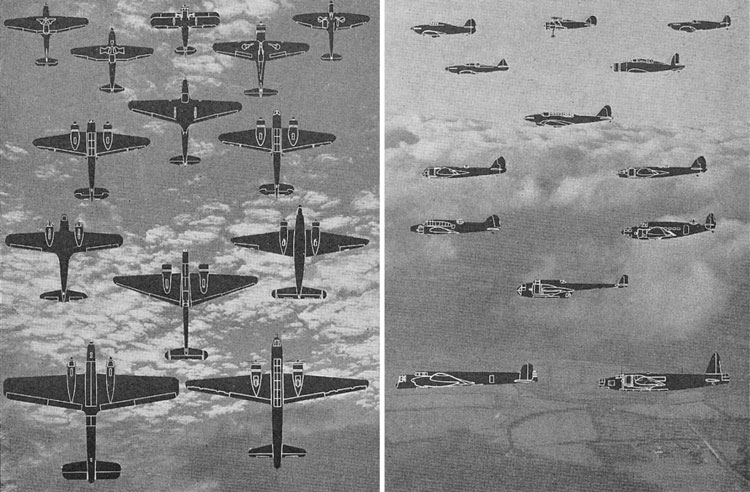
BRITISH MILITARY AEROPLANES.—Plan and side silhouettes of some of the leading British military aeroplanes seen from underneath and all drawn to the same scale. They are, left to right, top to bottom:—Single-seat Fighters—the Hawker Hurricane, the Gloster Gladiator, the Supermarine Spitfire; Two-seat Fighters—the Boulton Paul Defiant, the Blackburn Roc; Reconnaissance-Bombers—the Fairey Battle, the Bristol Blenheim /, the Bristol Blenheim IV, the Avro
Anson, the Lockheed Hudson, the Handley Page Hampden, the Armstrong Whitley IV, the Vickers-Armstrongs Wellington.
HEAD-ON VIEWS

German
Left to right, top to bottom: Heinkel He. 112, Messerschmitt Me. 109, Messerschmitt Me. 110, Heinkel He. 118, Junkers Ju. 87. Henschel Hs. 123, Dornier Do. 17, Dornier Do. 215, Heinkel He. III K, Junipers Ju. 86 K, Junkers Ju. 89.
British
Left to right, top to bottom: Supermarine Spitfire, Hawker Hurricane, Westland Lysander, Fairey Battle, Bristol Blenheim, Bristol Beaufort, /4/ison, Lockheed Hudson, Handley Page Hampden, Armstrong Whitworth Whitley, Vickers-Armstrongs Wellington.
HEAD-ON VIEWS
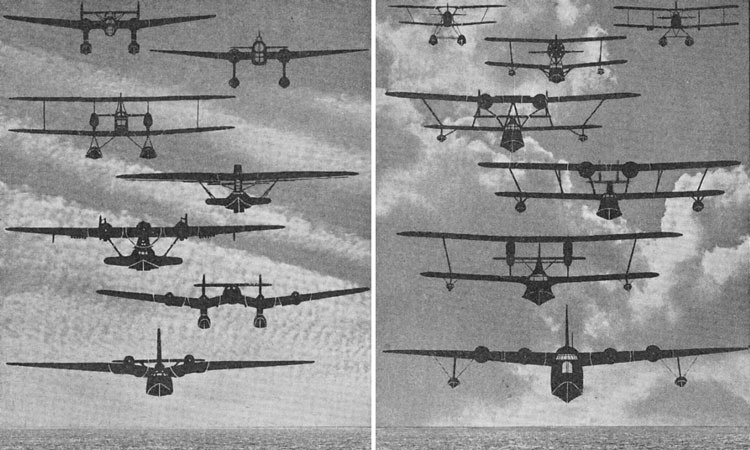
German
Left to right, top to bottom: The Blohm and Voss Ha. 140, Heinkel He. 115, Heinkel He. 59, Dornier Do. 18, Dornier Do. 24, Blohm and Voss Ha. 139, Dornier Do. 26.
British
Left to right, top to bottom: The Hawker Osprey, Fairey Sea Fox, Supermarine Walrus Fleet-spotter amphibian. Flying boats, the Saro London, Supermarine Stranraer, Short Singapore III, Short Sunderland.
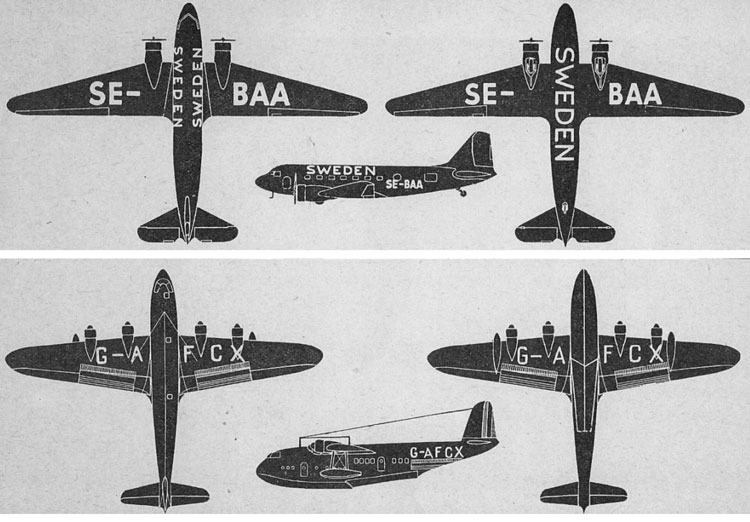
CIVIL IDENTIFICATION I.—A Douglas DC-3 of A.B. Aerotransport. The machine is painted orange, with registration letters
and "Sweden" in black.
CIVIL IDENTIFICATION II.—Short-Empire flying-boaty of Imperial Airways, used on the Empire routes. The flying-boats are not camouflaged but have red, white and blue markings under the registration letters and on the rudder.
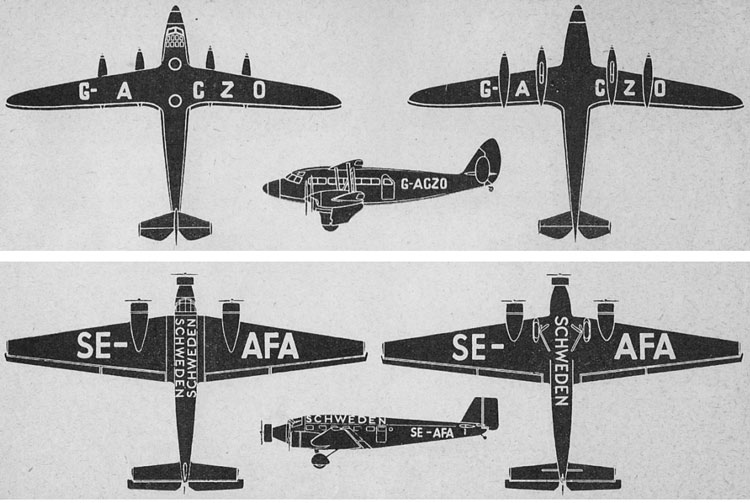
CIVIL IDENTIFICATION III.—A DH 86B of Jersey Airways on the Shoreham—Guernsey—Jersey services. It is camouflaged on the upper surfaces of the wings, fuselage and engine nacelles. Aer Lingus Teorantas DH 86s are camouflaged on the upper surfaces, yellow underneath, and have the Eire National colours on the fuselage. N.A.C. machines are completely camouflaged.
CIVIL IDENTIFICATION IV.—A Junkers Ju 52, of A.B. Aerotransport, from above, below and the side. The machine is painted orange,
with registration letters and " Sweden " in black.
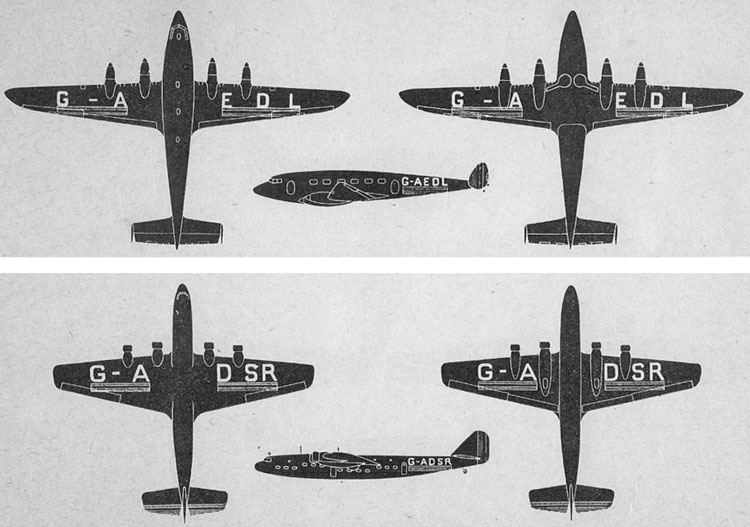
CIVIL IDENTIFICATION V.—A De Havilland 22-passenger Albatross, or Frobisher, of the type used by Imperial Airways.
CIVIL IDENTIFICATION VI.—An Armstrong Whitworth Ensign 40-passenger transport of the type operating on the Paris services of Imperial Airways and under N.A.C. It is camouflaged and has red, white and blue markings on the wings, fuselage and tail.